After another week of hard work, finishing making 2 kilos of art yarn and dyeing all the clubs AND clipping bunnies and being a nurse to Hilde, whose eye is almost healed completelya couple of weeks more to go and I think she’ll be a 100%- ! This weeks’ update is all about something super special and rare : Vicuna ! Also, I have to remind you that the sign ups for the next batch of IxCHeL Clubs are open but some and especially the fibre and batt club are filling up very very fast, so do not wait too long to secure your place. Now , here’s what you have been waiting for:
The Vicuna belongs to the camelid family, like the alpaca and the guanaco, but lives in the wild at an altitude of more than 4000 meters above sea level. You can find vicunas from as far north as Ecuador, Chile and Argentina. The vicuna is the smallest of the 4 south American camelids (Vicuna, guanaco, alpaca and llama). The colour of their fibre is caramel in colour with a white bib below their face. Their height is between 1 to 1.3 meters and they weigh approximately 35 to 40 kilos. Their fibres are classified as one of the most finest in the world with a micron count of appr 9 to 12micron with a staple length of about 3cms. You can find the vicuna in three kinds of social groups: the polygamous groups with 1 male and 10 females; a group of males and then there are the solitary males. The gestation period for vicunas is about 10 to 11 months.
The Vicuna belongs to the camelid family, like the alpaca and the guanaco, but lives in the wild at an altitude of more than 4000 meters above sea level. You can find vicunas from as far north as Ecuador, Chile and Argentina. The vicuna is the smallest of the 4 south American camelids (Vicuna, guanaco, alpaca and llama). The colour of their fibre is caramel in colour with a white bib below their face. Their height is between 1 to 1.3 meters and they weigh approximately 35 to 40 kilos. Their fibres are classified as one of the most finest in the world with a micron count of appr 9 to 12micron with a staple length of about 3cms. You can find the vicuna in three kinds of social groups: the polygamous groups with 1 male and 10 females; a group of males and then there are the solitary males. The gestation period for vicunas is about 10 to 11 months.
Centuries ago, the Inca harvested prized vicuña fibre by harmlessly shearing the animals, which they considered sacred. The exquisitely soft but ultra-warm garments created from vicuña wool were reserved for rulers/emperors, under threat of death for violators.
When the Spanish arrived, they were equally entranced by the fibres, but in keeping with their violent conquest of the Incan Empire in the 16th century, they simply killed vicuñas to access their wool. That method persisted until the 1960s, when just 10,000 vicuñas remained.
Realizing that the species was in danger of imminent extinction, conservationists and vicuña range-state governments began scrambling to save it; first by protecting the animals and outlawing trade in their wool; then in the 1990s and 2000s, by launching programs that harkened back to the old way of doing things: introducing community-led efforts to harmlessly and sustainably shear vicuñas and manage populations.
At first, the plan seemed to be working. Locals worked together to harvest the wool, which they then used to make handicrafts or sold to textile companies in Italy, Scotland and Japan. “The program started quite well, but for the past 15 years we’ve discovered a series of fundamental problems,” says Cristian Bonacic, currently a visiting professor at the University of Wisconsin, Madison, and permanently based at the Pontifical Catholic University of Chile.
Communities working directly with vicuñas, most of which are extremely poor, currently receive little profit for all their effort — “the smallest piece of the pie,” says Daniel Elias Maydana, a technical advisor for the National Association of Vicuña Fibre Producers who works in Bolivia and northern Argentina. “The money obtained from managing vicuñas is important, but it’s certainly not sufficient to lift families out of poverty.”
When the Spanish arrived, they were equally entranced by the fibres, but in keeping with their violent conquest of the Incan Empire in the 16th century, they simply killed vicuñas to access their wool. That method persisted until the 1960s, when just 10,000 vicuñas remained.
Realizing that the species was in danger of imminent extinction, conservationists and vicuña range-state governments began scrambling to save it; first by protecting the animals and outlawing trade in their wool; then in the 1990s and 2000s, by launching programs that harkened back to the old way of doing things: introducing community-led efforts to harmlessly and sustainably shear vicuñas and manage populations.
At first, the plan seemed to be working. Locals worked together to harvest the wool, which they then used to make handicrafts or sold to textile companies in Italy, Scotland and Japan. “The program started quite well, but for the past 15 years we’ve discovered a series of fundamental problems,” says Cristian Bonacic, currently a visiting professor at the University of Wisconsin, Madison, and permanently based at the Pontifical Catholic University of Chile.
Communities working directly with vicuñas, most of which are extremely poor, currently receive little profit for all their effort — “the smallest piece of the pie,” says Daniel Elias Maydana, a technical advisor for the National Association of Vicuña Fibre Producers who works in Bolivia and northern Argentina. “The money obtained from managing vicuñas is important, but it’s certainly not sufficient to lift families out of poverty.”
In 2014, for example, Peru exported 10 tons of vicuña fibre to Italy, for which all Peruvian communities combined received a grand total of $250,000. “That is ridiculously small,” Bonacic says.
A single coat, using just two kilos (4.4 pounds) of wool, can cost $50,000, he says, meaning that the fashion industry’s revenue from just five garments can equal the entire earnings that the whole of Peru’s vicuña-producing communities sees in a year.
Another tit-bit of information: there was even a political scandal called the “Vicuna coat Affair”: In 1958, Sherman Adams, President Dwight Eisenhower's forceful chief of staff, was one of Washington's most influential men. His career, however, ended abruptly after he accepted an overcoat from a textile magnate under federal investigation. The gift might seem innocuous enough, but the coat in question was made of vicuña—an incredibly soft, light, rare and very expensive yarn. It was alleged that Mr. Adams, swayed by such luxurious gifts, subsequently tried to influence federal agencies on the magnate's behalf. Despite the politico's protestations of innocence, he resigned in a scandal that some dubbed the Vicuña Coat Affair.
Now, the silky vicuna fibre sits at the nose-bleed-high pinnacle of tailored luxury. Each year, only 13,000 to 17,500 pounds of vicuña become available. The Italian tailoring house Kiton makes only about 100 vicuña pieces a year; an off-the-rack sport coat costs at least US$21,000, while the price of a made-to-measure suit starts at US$40,000. A single vicuña scarf is about US$4,000. There are only 30 vicuña suits produced per year. Each is numbered, and the most affordable model goes for US$46,500.
A single coat, using just two kilos (4.4 pounds) of wool, can cost $50,000, he says, meaning that the fashion industry’s revenue from just five garments can equal the entire earnings that the whole of Peru’s vicuña-producing communities sees in a year.
Another tit-bit of information: there was even a political scandal called the “Vicuna coat Affair”: In 1958, Sherman Adams, President Dwight Eisenhower's forceful chief of staff, was one of Washington's most influential men. His career, however, ended abruptly after he accepted an overcoat from a textile magnate under federal investigation. The gift might seem innocuous enough, but the coat in question was made of vicuña—an incredibly soft, light, rare and very expensive yarn. It was alleged that Mr. Adams, swayed by such luxurious gifts, subsequently tried to influence federal agencies on the magnate's behalf. Despite the politico's protestations of innocence, he resigned in a scandal that some dubbed the Vicuña Coat Affair.
Now, the silky vicuna fibre sits at the nose-bleed-high pinnacle of tailored luxury. Each year, only 13,000 to 17,500 pounds of vicuña become available. The Italian tailoring house Kiton makes only about 100 vicuña pieces a year; an off-the-rack sport coat costs at least US$21,000, while the price of a made-to-measure suit starts at US$40,000. A single vicuña scarf is about US$4,000. There are only 30 vicuña suits produced per year. Each is numbered, and the most affordable model goes for US$46,500.
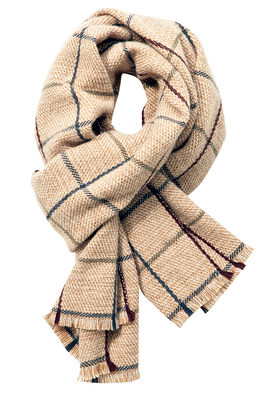 |
| Handspun and handwoven vicuna and cashmere scarf, the price to the end consumer US$17.000 , the reward given to artists and poor communities ensuring the ethical shearing of vicunas: a tiny, tiny fraction . spin and weave your own ethically |
In 2008, a high end Italian fashion house established an eight-square-mile reserve to study the animals. And earlier this year, the company took a controlling stake in Sanin SA, an Argentinean firm that has the rights to shear around 6,000 wild vicuña living on a 328-square-mile territory in the country's Catamarca province. It's part of it's long-term strategy to establish large reserves where the local people can protect, breed and shear vicuña ethically.
Vicuñas are now listed as a species of “Least Concern” according to the International Union for Conservation of Nature, but most experts agree that there is cause for concern. Vicuña populations now hover at 400,000 to 500,000 animals, but their numbers have remained stagnant or — in the case of Chile — declined over the past two decades.
A beautiful blend of Vicuna (40%), Muga Silk (30%), Cashmere(30%)
28grams in a nice gift package AU$60
to put this price in perspective: 28 grams of pure vicuna is priced at around US$250 !
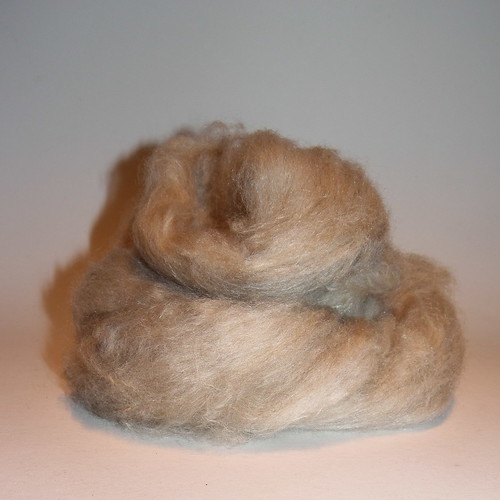
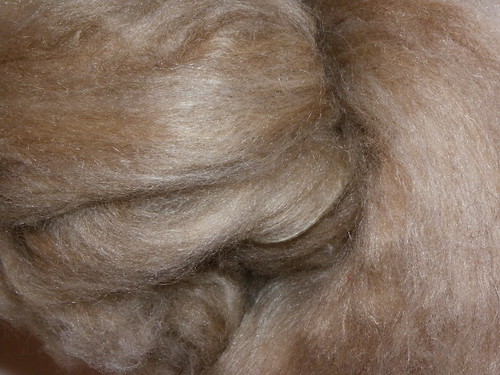
vicuna blend top
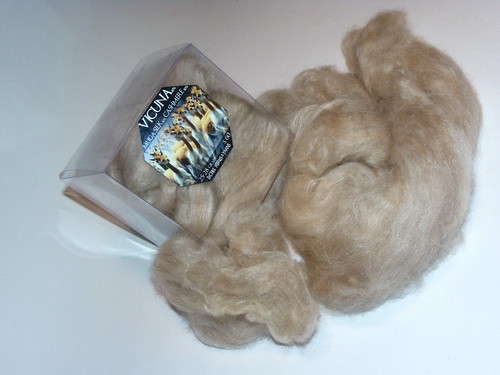
Vicuñas are now listed as a species of “Least Concern” according to the International Union for Conservation of Nature, but most experts agree that there is cause for concern. Vicuña populations now hover at 400,000 to 500,000 animals, but their numbers have remained stagnant or — in the case of Chile — declined over the past two decades.
“It’s true that populations are large, but they’re far less than the 7 to 8 million that we should have,” Bonacic says. “I seriously think that if poaching continues to increase, some populations may go extinct.”
As in everything in this world, we as consumers and fibre artists have to be aware of where the fibre comes from but more than anything to realise that everything comes at a price: there is no way that handpicked, hand carded, fibres of a rare breed that is carefully hand sheared can be offered with low prices.
What we see happening all over the world is that the wealthy end consumer pays a huge amount of money of which only a tiny fraction goes to the preservation and the maintaining of the natural habitat and the poor communities that live off the land. We all have to be conscious that this attitude has to change.
I have been trying to do my bit with bringing rare breeds to you and trying to tell you the story of how importantant it is to preserve and protect. You may think how can 1 person change something? But I truly believe you can. We all can make a change together. So with this story of this truly royal and exquisite animal, I offer you a magnificent blend. Do your bit and help this amazing animal survive and make life better for numerous poor communities who are doing the right thing.
As in everything in this world, we as consumers and fibre artists have to be aware of where the fibre comes from but more than anything to realise that everything comes at a price: there is no way that handpicked, hand carded, fibres of a rare breed that is carefully hand sheared can be offered with low prices.
What we see happening all over the world is that the wealthy end consumer pays a huge amount of money of which only a tiny fraction goes to the preservation and the maintaining of the natural habitat and the poor communities that live off the land. We all have to be conscious that this attitude has to change.
I have been trying to do my bit with bringing rare breeds to you and trying to tell you the story of how importantant it is to preserve and protect. You may think how can 1 person change something? But I truly believe you can. We all can make a change together. So with this story of this truly royal and exquisite animal, I offer you a magnificent blend. Do your bit and help this amazing animal survive and make life better for numerous poor communities who are doing the right thing.
You can find the Vicuna blend tops on offer this week after the IxCHeL club membership sign up information. Please don't hesitate to contact me at any. All my contact details and HOW TO ORDER can to be found at the end of this week’s blog entry.
New IxCHeL Club sign ups are open
for the months : October, November and December 2016
for the months : October, November and December 2016
(til quotas are reached or until October 1st)
For all our international club fans there is a possibility to ship all three clubs together to save on postage if you want :-) Just pm me and enquire about the options available.
IxCHeL Fibre Club October, November and December 2016
The subscription is for a period of three months and you will receive one special hand dyed top/roving per month to the value of AU$24 or more
All the tops will be hand dyed and will be especially made for the members of Ixchel Fibre Club !
Price to join the IxCHel Fibre Club #30 and receive your special hand dyed top :)) for three months (October, November and December) 2016) is AU$72 + postage (parcel post or airmail). AND there are good value double serves available !!!
For Australia : single serve $72+$28 postage (parcel post), double serve $136+$28 (save $8) or triple serves $204 (save $12!) + postage
For USA + Canada: single serve AU$72+AU$56 (Airmail) double serve AU$136+AU$56
For UK,Europe, rest of the world: Single serve AU$72+AU$69 (airmail) Double serve AU$136+AU$69
For Asia: Single serve AU$72+AU$50 (airmail) Double serve AU$136+AU$50
If you want to receive a fibre surprise every month then join the IXCHEL FIBRE CLUB #30 now. Numbers are strictly limited ! The October 2016 Club is going to be shipped out end of October. Payment via direct deposit or credit card or paypal. Just PM or email me your details
The IxCHeL Sock Yarn Clubs October, November and December 2016
Every month for three months (October, November and December2016) you will receive: enough hand dyed luscious yummy yarn to make a pair of socks or a lush shawl or scarf ofcourse! (the hand dyed yarn will be exclusive for the Ixchelbunny SOCK-IT-TO-ME Yarn CLUB and will range from a sockweight yarn or a 3ply or a 4 ply); Every month a new sock pattern, tips and instructions ! Now is that GOOD or is that GOOD ??!
I will even offer a double serve for those of you who like their socks extra long !
For Australia : single serve $78+$28 postage (parcel post) double serve $130 (= one skein FREE!!!) +$28
For USA + Canada: single serve AU$78+AU$56 (Airmail) double serve $130 (= one skein FREE!!!) +AU$56
For UK,Europe, rest of the world: Single serve AU$78+AU$69 (airmail) Double serve $130 (= one skein FREE!!!) +AU$69
For Asia: Single serve AU$78+AU$45 (airmail) Double serve $130 (= one skein FREE!!!) +AU$45
Numbers are strictly limited !
Payment via direct deposit or credit card or paypal . Just PM or email me your details
By the way: you don’t HAVE to knit socks if you don’t want to.. the hand dyed yarn is amazingly nice for scarves, cowls, beanies and even tops ! Anything goes .
IxCHeL Funky Bunny Batt Clubs October , November and December 2016
Here are all the details and just pm me when you have any questions or want to be part of the funky bunny batt club Movement ;-) Welcome to the blingy dark side ;-D
The subscription is for a period of three months and you will receive one special hand dyed funky bunny batt per month to the value of AU$40 or more .
The batts will range in weight from 140grams to 180grams with luxury fibres like camel , angora, cashmere, silk, yak, llama even wolf and bison and rare sheep breeds !!!! All the batts will be hand dyed and will be especially made for the members of Ixchel funky bunny Club ! Every month you will receive a HUGE luxury funky bunny batt !
Sign up now and you will receive an Ixchel Hand dyed , super luxurious funky bunny batt for October, November and December 2016.
Price to join the Ixchel Funky bunny for three months is :
For Australia : $108+$28 postage (parcel post)
For USA + Canada: AU$108+AU$56 (Airmail)
For UK,Europe, rest of the world: AU$108+AU$69 (airmail)
If you want to receive a fibre surprise every month then join the IXCHEL FUNKY BUNNY BATT CLUB now. Numbers are strictly limited ! The first installment is going to be shipped out end of October Payment via direct deposit or credit card or paypal. Just PM or email me
Have a creative week!
Vicuna Blend Tops SOLD
A beautiful blend of Vicuna (40%), Muga Silk (30%), Cashmere(30%)
28grams in a nice gift package AU$60
to put this price in perspective: 28 grams of pure vicuna is priced at around US$250 !


vicuna blend top

Vicuna and it’s packaging
2nd of October
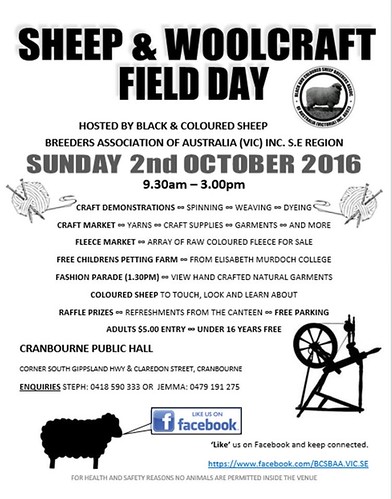

Dates to put in your Calendar !!
OCTOBER
2nd of October
Black n Coloured Sheep FIELD DAY in Cranbourne!

Landscape dyes
100g tubs AU$11
Want to dye your own with easy to use acid dyes? I have been selling these Landscape dyes at my workshops and shows for a long time : They are extremely easy to use and come in great shades.
Just contact me with the name of the colour you are after and I will get right back to you.
Just contact me with the name of the colour you are after and I will get right back to you.
Have a creative week!
Please don't hesitate to contact me at any time if you have any questions okay? : Always happy to enable.
All my contact details are here:
How To Order:
1. You can email me on ixchel at rabbit dot com dot au or ixchelbunny at yahoo dot com dot au
2. Message me on facebook or
3. Message me on www.ravelry.com where I am Ixchelbunny.
I will email you right back with all your order details and payment methods.
Any questions? Any custom orders for yarn or dyeing fibre? : Please don’t hesitate to ask! Always happy to enable.
2. Message me on facebook or
3. Message me on www.ravelry.com where I am Ixchelbunny.
I will email you right back with all your order details and payment methods.
Any questions? Any custom orders for yarn or dyeing fibre? : Please don’t hesitate to ask! Always happy to enable.
Thank you so much for your help and support !
RABBIT ON !
((hugs))
Charly




No comments:
Post a Comment